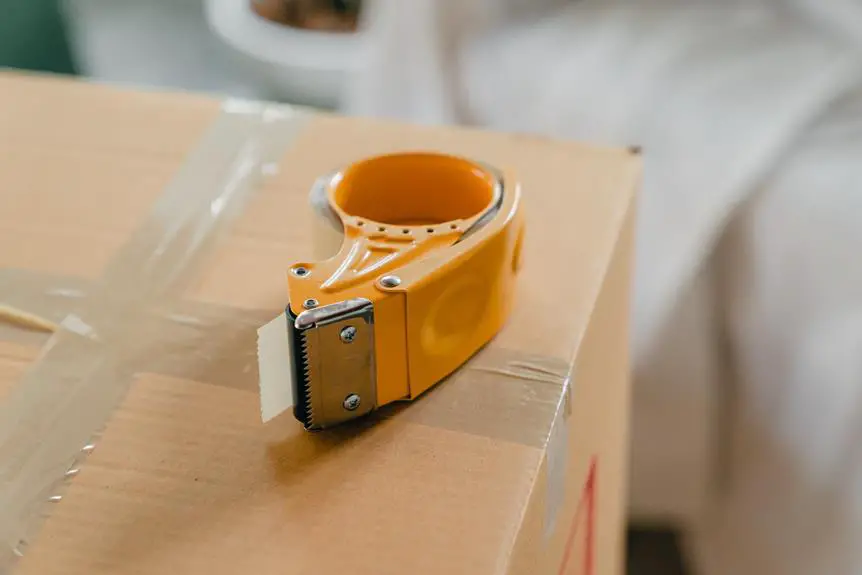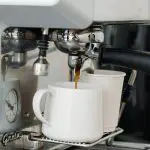When you're working on a sewing project and need a quick and precise hem, a handheld Scotch tape dispenser can be your secret weapon. Simply fold the fabric to the desired length, use the tape dispenser to secure the fold in place, and then sew along the edge for a perfectly even hem.
But that's just the beginning. From pattern alignment to temporary marking, the versatile tape dispenser can revolutionize your fabric crafts. In this guide, you'll discover 10 fabric-friendly ways to harness the power of a handheld Scotch tape dispenser, allowing you to achieve professional-looking results with ease and precision.
Key Takeaways
- Handheld Scotch tape dispenser can be used for quick hemming and seam repair, offering a convenient alternative to traditional sewing methods or adhesive tapes.
- It can be used to secure patterns in place without damaging the fabric, allowing for accurate fabric positioning and preventing shifting and misalignment during sewing.
- The tape dispenser can create temporary markings on fabric without leaving residue, making it easy to mark hems, seams, or pattern adjustments before sewing.
- It can also be used to secure trims and embellishments without sewing or messy glue, providing a strong and long-lasting bond and allowing for easy placement adjustment before making it permanent.
Hemming and Seam Repair
Use a handheld Scotch tape dispenser to quickly mend hems and repair seams on your fabric items. This innovative fabric repair technique is tape-free and fabric-friendly. Rather than using traditional sewing methods or adhesive tapes, a handheld tape dispenser offers a convenient alternative for quick hemming and seam repair.
The dispenser applies a thin, precise line of adhesive that's gentle on fabrics, making it an ideal solution for temporary fixes or for those who prefer not to sew.
When using a handheld tape dispenser for fabric repair, it's important to select the right type of tape that's specifically designed for fabric use. Look for options that are durable, yet easy to remove without leaving residue or damaging the fabric. Additionally, consider practicing on a small, inconspicuous area of the fabric to ensure compatibility and to perfect the application technique.
Whether you're adjusting the length of a pair of pants or fixing a torn seam, a handheld tape dispenser can offer a quick and effective solution for fabric repairs, all without the need for traditional sewing or adhesive tapes.
Pattern Placement and Alignment
To achieve precise pattern placement and alignment on your fabric items, consider utilizing the handheld Scotch tape dispenser's gentle adhesive application for a fabric-friendly approach.
When working with patterned fabrics, precise pattern matching and fabric manipulation are essential for a professional finish. Before cutting your fabric, carefully position and align the pattern to ensure continuity across seams and hems. The handheld Scotch tape dispenser can be used to secure the pattern in place without leaving any residue or damaging the fabric.
When working with multiple pattern pieces, use the tape to coordinate the print placement, ensuring a seamless transition between sections. This method allows for accurate fabric positioning and print coordination, resulting in a cohesive and polished look.
Additionally, the tape can be used to temporarily secure fabric layers during sewing, preventing shifting and misalignment. By incorporating the handheld Scotch tape dispenser into your pattern placement and alignment process, you can achieve professional results while preserving the integrity of your fabric.
Temporary Fabric Marking
When working with fabric, a handheld Scotch tape dispenser can be a handy tool for creating temporary markings. By using tape for fabric, you can easily mark placements, hems, or seam lines without causing damage to the textile.
This method provides a safe and effective way to make temporary adjustments during the sewing or crafting process.
Tape for Fabric
First, grab a handheld Scotch tape dispenser to easily mark fabric for temporary alterations or sewing projects. When using tape for fabric, it's important to choose the right type of tape to avoid leaving residue or damaging the fabric. Here are some tips for using tape as a temporary fabric marking tool:
- Use low-tack or painter's tape to avoid leaving sticky residue on the fabric.
- Test the tape on a small, inconspicuous area of the fabric to ensure it doesn't cause damage or leave marks.
- Avoid using regular clear tape or duct tape, as they may leave residue or damage delicate fabrics.
- Use tape to mark hems, seams, or pattern adjustments before sewing to ensure accurate placement.
- Remove the tape gently after marking to prevent any pulling or distortion of the fabric.
When used carefully, tape can be a helpful tool for temporary fabric marking without causing damage or leaving permanent marks.
Easy Temporary Markings
Grab your handheld Scotch tape dispenser and start marking fabric for temporary alterations or sewing projects with ease.
When you need to make temporary markings on fabric, using a handheld Scotch tape dispenser can be a game-changer. It allows for fabric-friendly organization, providing a clear and easy way to mark fabric without causing any damage.
For temporary alterations, you can use the tape to mark hems, darts, or other adjustments without leaving any residue.
Additionally, when working on creative fabric embellishments, such as appliqué or intricate designs, the tape can help you map out your patterns before sewing. This method ensures precision and accuracy without the need for messy fabric markers or chalk.
With this simple yet effective technique, you can confidently tackle your sewing projects with temporary markings that won't compromise the fabric's integrity.
Safe for Textiles
Ensure that your handheld Scotch tape dispenser is safe for textiles when using it for temporary fabric marking. When working with delicate fabrics, it's important to follow fabric preservation techniques. Here are some tips to help you use a handheld Scotch tape dispenser safely on textiles:
- Use the dispenser on a small, inconspicuous area first to test for any adverse effects.
- Avoid leaving the tape on the fabric for an extended period to prevent adhesive residue.
- When removing the tape, do so gently to avoid damaging the fabric fibers.
- Prior to ironing, ensure that all tape residue has been completely removed to avoid it becoming permanently adhered to the fabric.
- In case of accidental tape transfer or stains, refer to appropriate stain removal techniques for delicate fabrics.
Securing Trims and Embellishments
To secure trims and embellishments with a handheld Scotch tape dispenser, carefully align the tape along the edges for a neat and durable hold. When attaching fabric trims or embellishments, using a fabric adhesive tape can provide a strong and long-lasting bond without the need for sewing or messy glue. Simply place the tape along the edge of the trim or embellishment and press firmly to secure it in place. This method is particularly useful for delicate fabrics or intricate embellishments that may be difficult to sew or glue by hand.
For heavier trims or embellishments, consider using the tape as a temporary attachment method before sewing or gluing for added reinforcement. By securing the items in place with the tape first, you can easily adjust their placement before making it permanent with sewing or fabric glue. This can be especially helpful when working with intricate designs or arranging multiple embellishments on a garment or accessory.
Creating Fabric Stencils
To create fabric stencils, you'll need to master precision cutting techniques to achieve clean lines and intricate designs.
Choosing a suitable stencil material is crucial for durability and reusability, making sure it can withstand multiple uses without losing its shape.
Securing the stencil for painting is a key step to prevent smudging and ensure crisp, professional-looking results.
Precision Cutting Techniques
For precise cutting when creating fabric stencils, use a sharp pair of fabric scissors to ensure clean and accurate lines. To achieve the best results, follow these precision cutting techniques:
- Use a Cutting Mat: Place a self-healing cutting mat under the fabric to protect your work surface and ensure smooth, uninterrupted cuts.
- Secure the Fabric: Use fabric weights or clips to secure the fabric in place, preventing shifting and ensuring precise cutting.
- Sharp Blades: Ensure your fabric scissors are sharp to effortlessly glide through the fabric, minimizing fraying and uneven edges.
- Practice Controlled Movements: Use controlled, steady movements when cutting to maintain accuracy and prevent jagged edges.
- Regular Maintenance: Keep your scissors clean and well-maintained to optimize their cutting performance and prolong their lifespan.
Choosing Suitable Stencil Material
When creating fabric stencils, start by selecting a suitable stencil material that allows for clean and crisp design transfer. Choosing durable stencils is essential to ensure that they can withstand multiple uses without losing their shape or integrity. Look for materials like mylar or thick acetate, which are sturdy and can be easily cleaned for reuse.
Additionally, consider the size of the stencil material to ensure that it fits the dimensions of your project and allows for easy maneuvering during the stenciling process. Once you have chosen the appropriate material, explore stencil storage solutions to keep them organized and protected. Storing stencils flat in a designated container or folder can help prevent warping or damage, ensuring their longevity for future use.
Securing Stencil for Painting
Once you have selected a suitable stencil material, secure it firmly in place on the fabric using a handheld Scotch tape dispenser to prevent any shifting or movement during the painting process.
To ensure proper stencil maintenance and fabric protection, follow these steps:
- Start by laying the fabric flat on a smooth surface.
- Position the stencil on the fabric and use the handheld Scotch tape dispenser to secure the edges of the stencil to the fabric.
- Make sure to press the tape down firmly to prevent any seepage of paint under the stencil.
- Double-check that the stencil is completely flat and secured before starting the painting process.
- After painting, gently remove the tape and stencil to reveal your painted design while ensuring the fabric remains undamaged.
These steps will help you create beautifully painted fabric stencils while keeping the fabric protected and the stencil well-maintained.
Tackling Fabric Frays
To tackle fabric frays, grab the handheld Scotch tape dispenser and gently press the adhesive along the frayed edges to secure the threads in place. This method is effective for repairing tears and preventing unraveling, as it helps hold the fabric together and prevents further damage. When using the tape dispenser, make sure to apply light pressure to avoid distorting the fabric or causing any damage.
Start by identifying the frayed areas on the fabric. Once located, carefully run the adhesive along the edges of the frayed threads, ensuring that they're all pressed down securely. Take care not to pull or stretch the fabric excessively while doing this. The adhesive from the Scotch tape will provide a temporary fix, preventing the frays from getting worse and giving you time to apply a more permanent solution later.
Remember that while using the tape dispenser is a quick and easy way to address fabric frays, it isn't a substitute for more thorough fabric mending techniques. This method is best used for temporary fixes or as a preventive measure until proper repairs can be made.
DIY Fabric Tape
You can easily create your own fabric tape using a handheld Scotch tape dispenser. DIY fabric tape offers a versatile and creative way to enhance fabric-related projects.
Here are five simple steps to make your own fabric tape:
- Select Fabric: Choose a fabric that complements your project, whether it's for a fabric tapestry display, DIY fabric jewelry, fabric tape art, or fabric tapestry hanging. Consider textures and colors that align with your desired outcome.
- Prepare Fabric Strips: Cut the selected fabric into thin, even strips. Ensure the strips are of a suitable length and width for your specific application.
- Apply Adhesive: Use a handheld Scotch tape dispenser to evenly apply adhesive along one side of the fabric strips. This will transform them into fabric tape that can be easily applied to various surfaces.
- Trim Excess: Trim any excess fabric from the edges to ensure clean, neat edges and a professional finish.
- Store and Use: Roll the fabric tape onto the handheld dispenser for easy storage and convenient use in your fabric-related projects.
Creating your own fabric tape allows for personalized and unique embellishments, making it a valuable addition to your crafting repertoire.
Custom Fabric Labels
The handheld Scotch tape dispenser can be utilized to create custom fabric labels for your handmade garments and crafts. Personalizing garments with custom fabric labels adds a professional touch and helps convey important information such as fabric care and washing instructions.
To create custom fabric labels using a handheld Scotch tape dispenser, start by designing your label on a computer or by hand. Then, print the design onto a piece of fabric using an inkjet printer. Once the ink is dry, place a piece of clear tape over the printed design.
Use the tape dispenser to cut around the label, leaving a small border of tape to seal the edges. Trim any excess tape, and your custom fabric label is ready to be attached to your garment or craft. This method ensures that your personalized fabric labels are durable and can withstand regular washing and wear.
Quilting and Patchwork Aid
One beneficial application of a handheld Scotch tape dispenser for quilting and patchwork is creating precise seam guides for accurate stitching. By using the tape dispenser, you can easily mark seam allowances on your fabric, ensuring consistent and precise stitching lines throughout your quilting project. This simple tool can greatly aid in maintaining uniform seam allowances and achieving professional-looking results in your quilting and patchwork designs.
- Seam Alignment: Use the tape dispenser to align fabric pieces accurately before stitching, ensuring perfect seam matching.
- Pattern Assembly: Securely attach pattern pieces together with tape to prevent shifting while cutting fabric for patchwork designs.
- Fabric Organization: Label and organize fabric pieces by using tape to mark different sections or block placements within a quilt.
- Binding Assistance: Utilize the tape dispenser to hold quilt binding in place before sewing it onto the quilt edge for a neat and tidy finish.
- Template Creation: Construct templates for quilting techniques such as appliqué or curved piecing by taping together clear plastic sheets or paper.
Incorporating a handheld Scotch tape dispenser into your quilting and patchwork process can streamline your workflow and elevate the precision of your projects.
Fabric Scrapbooking Accents
Looking to add a unique touch to your fabric scrapbooking projects?
The handheld Scotch tape dispenser can be a versatile tool for creating fabric embellishments.
From adding decorative borders to securing small fabric accents, there are many creative ways to incorporate tape into your fabric scrapbooking designs.
Tape for Fabric Embellishments
How can you use a handheld Scotch tape dispenser to create fabric embellishments for your scrapbooking projects?
When it comes to fabric embellishment techniques, using a handheld Scotch tape dispenser can be a game-changer. Here are some innovative ways to utilize tape for fabric embellishments:
- Create clean and precise lines for fabric borders or frames.
- Use double-sided tape to affix delicate fabric details without messy glue.
- Secure fabric ribbons or trims seamlessly onto your scrapbooking projects.
- Add dimension to your fabric embellishments by layering different textures with ease.
- Easily adhere fabric cutouts or patches onto your scrapbook pages without the need for sewing.
Versatile Fabric Tape Uses
To enhance your fabric scrapbooking accents, consider incorporating versatile fabric tape uses to add depth and texture to your designs.
Fabric tape provides a quick and easy way to bond fabric pieces together, creating visually appealing layers in your scrapbook layouts.
Use fabric tape to secure delicate embellishments such as lace, ribbons, or fabric flowers onto your pages.
It's also handy for fabric repairs, allowing you to mend torn or frayed fabric elements within your scrapbook without the need for sewing.
When adhering fabric to paper, fabric tape offers a secure hold without causing damage or warping.
Frequently Asked Questions
Can a Handheld Scotch Tape Dispenser Be Used for Delicate Fabrics Like Silk or Chiffon?
Yes, a handheld Scotch tape dispenser can be used on delicate fabrics like silk or chiffon. It's a gentle way to mend tears or secure hems without causing damage. Simply apply the tape carefully and remove it with caution.
How Do I Clean a Handheld Scotch Tape Dispenser to Prevent It From Leaving Residue on My Fabric?
To clean a handheld Scotch tape dispenser and prevent residue on fabric, gently wipe the cutting blade and roller with a damp cloth. Avoid using harsh chemicals that could damage the dispenser or leave behind a film on your delicate fabrics.
Can I Use a Handheld Scotch Tape Dispenser to Attach Fabric to Paper for Scrapbooking?
Yes, you can use a handheld Scotch tape dispenser to attach fabric to paper for scrapbooking, but be cautious with delicate fabrics like silk and chiffon. Clean the tape dispenser thoroughly to prevent residue and gently remove tape to avoid damaging the fabric.
What Is the Best Way to Remove Scotch Tape From Fabric Without Damaging It?
To remove scotch tape from fabric without damaging it, gently lift the edge of the tape and use a hairdryer on low heat to soften the adhesive. Then, carefully peel off the tape. Avoid pulling forcefully to prevent fabric damage.
Can I Use a Handheld Scotch Tape Dispenser for Fabric Wall Stenciling?
Yes, you can use a handheld Scotch tape dispenser for fabric wall stenciling. It can help create crisp lines and prevent bleeding of paint. Apply the tape along the stencil edges, press firmly, and paint with fabric-friendly techniques.
- How Does Ring Spun Cotton Affect Garment Fit and Shape Retention? - August 13, 2024
- What Are the Challenges in Producing Ring Spun Cotton? - August 13, 2024
- Is Ring Spun Cotton Suitable for Plus-Size Clothing? - August 13, 2024






